Unlock More Muscle With These 7 Science-Backed Exercises
Little-known Exercises and Smart Variations to Transform Your Physique, Lose Fat, and Target Weak Links for Maximum Results
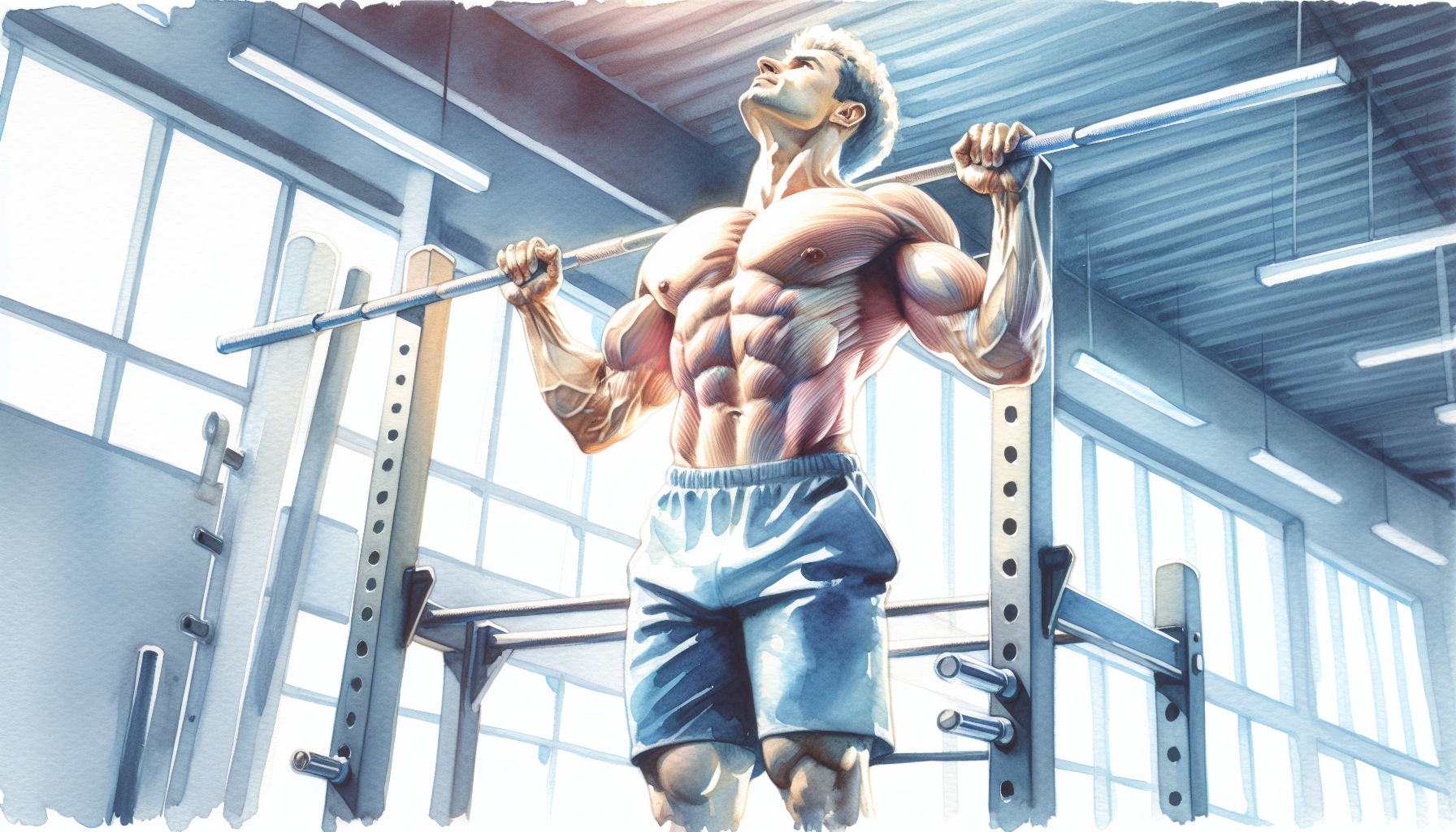
Key Takeaways
- You can boost shoulder health and grip by dead hanging for 30–120+ seconds.
- You’ll target mid-back thickness with Keelso shrugs using locked-arm rows.
- You can build glute and hamstring size without heavy bars using seated cable deadlifts.
Try This Today
✔ Perform a dead hang test: time a single unbroken hang. Aim to add 5–10 seconds per session for the next 4 workouts.
Want to unlock more muscle and better shoulder health?
In this expert review, we analyze, critique, and expand on Jeff Nippard's list of seven underrated exercises and show you how to use them to build more muscle, lose fat, and improve your physique.
What makes this review different?
- Carefully reviewed and fact-checked by experts
- Little-known tips to get more muscle and less fat from each move
- Complete workout plan inspired by isolating weak links and tension profiles
Why should you listen to us? Our articles are reviewed by exercise scientists with PhDs from top universities and 60+ years of combined training experience. We combine serious academic credentials with decades of practical training experience to give you science-backed advice you can trust. We've published 300+ articles so far.
Keep reading to learn exact technique cues, variations, programming, safety tips, and a ready-to-use workout plan so you can implement these seven exercises this week.
Related:
In a Nutshell: Seven Underrated Exercises
You can add small, targeted exercises to smash sticking points and build shape. These seven moves help shoulders, arms, rear delts, mid-back thickness, abs, and the posterior chain. You’ll use smarter ranges, better tension profiles, and safer load paths that let you train hard more often.
You’ll get: exact cues, progressions, and program ideas for each exercise. You can add one or two into any program right away.
You’ll finish this article with a mini-program and practical troubleshooting tips to keep you moving forward.
Key Concepts
- Tension Profile: Changing body angles alters where and when a muscle feels the load.
- Isolation vs. Compound Carryover: Isolating weak tissues can remove early failure from smaller muscles.
- Range Of Motion Specificity: Hitting the stretched position matters for shape and balanced development.
Upper-Body Hidden Gems
Dead Hang — The Simple Fix For Shoulders, Core, And Grip
The dead hang is one of the most underappreciated basic tools in the gym. It does a lot of small things well. It decompresses the spine a bit, opens the shoulder joint, builds forearm endurance, and trains core and breathing under passive load. It’s also an easy test to track progress in grip and shoulder tolerance.
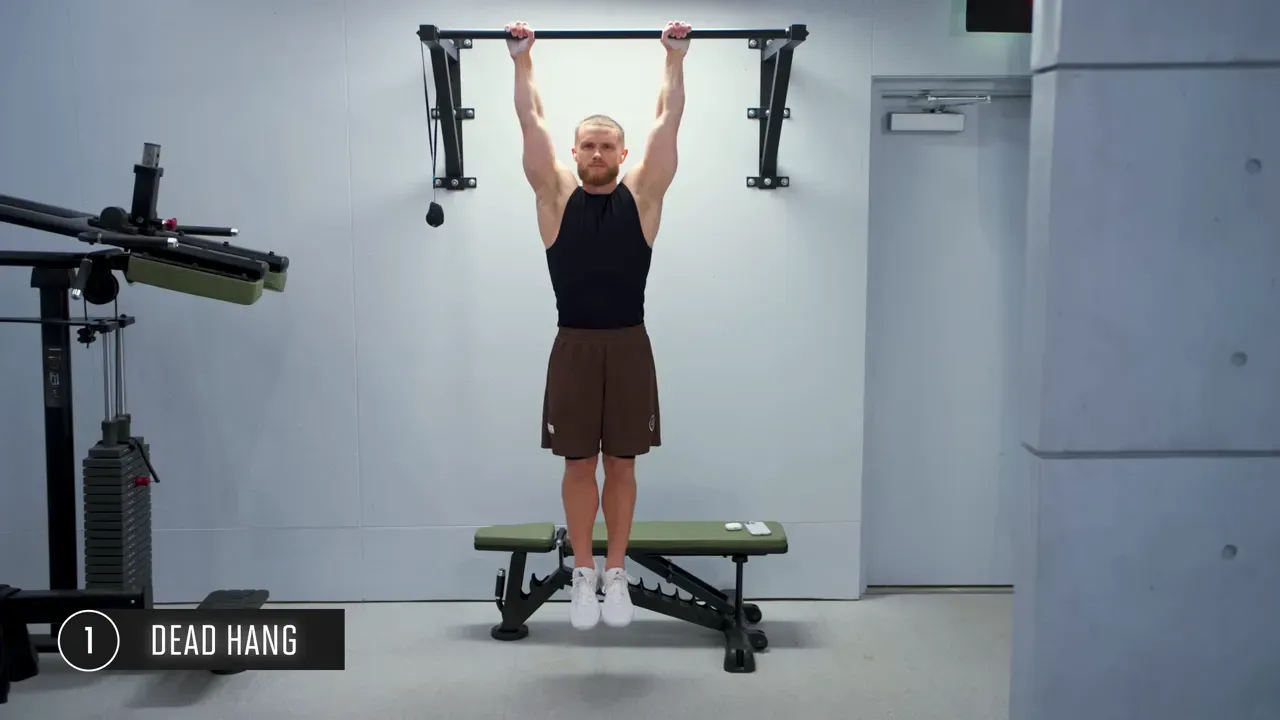
Why You Should Care
- Shoulder mobility: Hanging allows the rotator cuff and capsule to move into lengthened positions.
- Spinal relief: A controlled passive stretch can reduce stiffness after long sitting or heavy squats.
- Grip/endurance: Hanging builds forearm endurance that carries to rows, pull-ups, and deadlifts.
How To Do It Right
- Chalk your hands if available. Liquid chalk helps when gyms lack chalk.
- Grip the bar just outside shoulder width. Start looser to pace your forearms; squeeze more later.
- If testing max time, brace core but avoid maximal Valsalva; breathe. If decompressing, relax hips under control to stretch back.
- Keep feet together and toes pointed to reduce swing. Maintain a steady breathing rhythm.
Progressions And Variations
- Assisted band: Step into a loop for reduced load.
- Assisted pull-up machine: Adjust counterweight for support.
- Weighted hangs: Once you exceed ~90–120s, add weight for grip strength.
Programming Tip
Test your max hang time. Record it. Add short “hang sets” after upper-body days: 3–5 sets of 20–60s depending on your goal (endurance vs. decompression).
Zapman Hammer Curl — Smarter Negatives For Bigger Arms
The Zapman hammer curl is a small grip trick to bias the negative onto your biceps while letting the brachialis and brachioradialis help you on the concentric. It uses a grip switch mid-rep to shift the muscle emphasis. The logic is simple: you’re stronger eccentrically than concentrically, so load the negatives more.
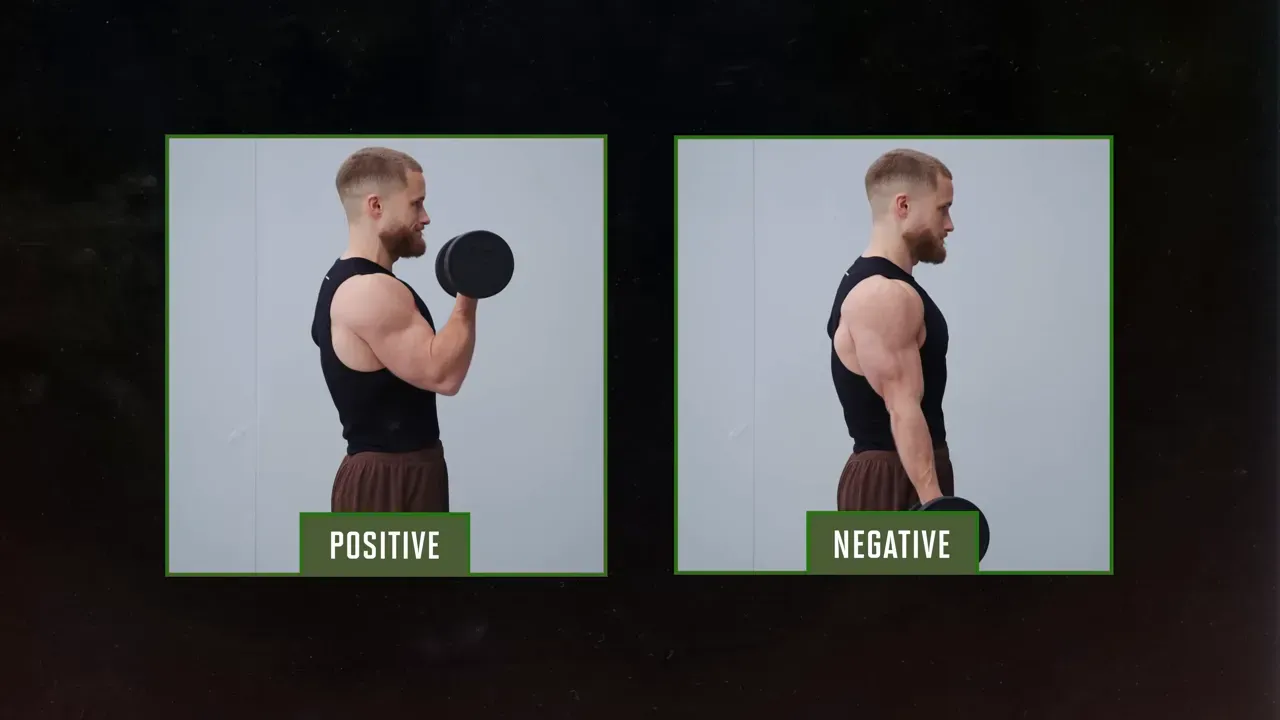
Why It Works
- You use a hammer grip on the concentric so strong brachialis and brachioradialis help.
- Rotate to supination on the eccentric. Your biceps become the prime mover on the harder negative.
- Longer time under tension on the negative is a strong hypertrophic stimulus.
Technique Cues
- Grip the dumbbell in the middle of the handle. Don’t rest your thumb on the head.
- Curl up in a neutral/hammer grip. Stop just before your forearm becomes vertical.
- Rotate palms to face up and lower in a wide arc under control. Stop at your sides and rotate back to hammer.
- Perform 8–10 reps. Slow the negative to about 3–4 seconds for maximal effect.
Coaching Notes
This won’t magically add inches compared to classic curls. But it adds a practical eccentric overload method without a partner. If you prefer standard curls, deliberately slow the negative to balance the strength curve.
Incline Dumbbell Y Raise — Build Side Delts With Better Tension
The incline dumbbell Y raise changes the tension profile of a lateral raise. In standing laterals, most tension sits at the top due to gravity. On an incline, you create a more even tension through the mid-range and better target fibers between front and side deltoid heads.
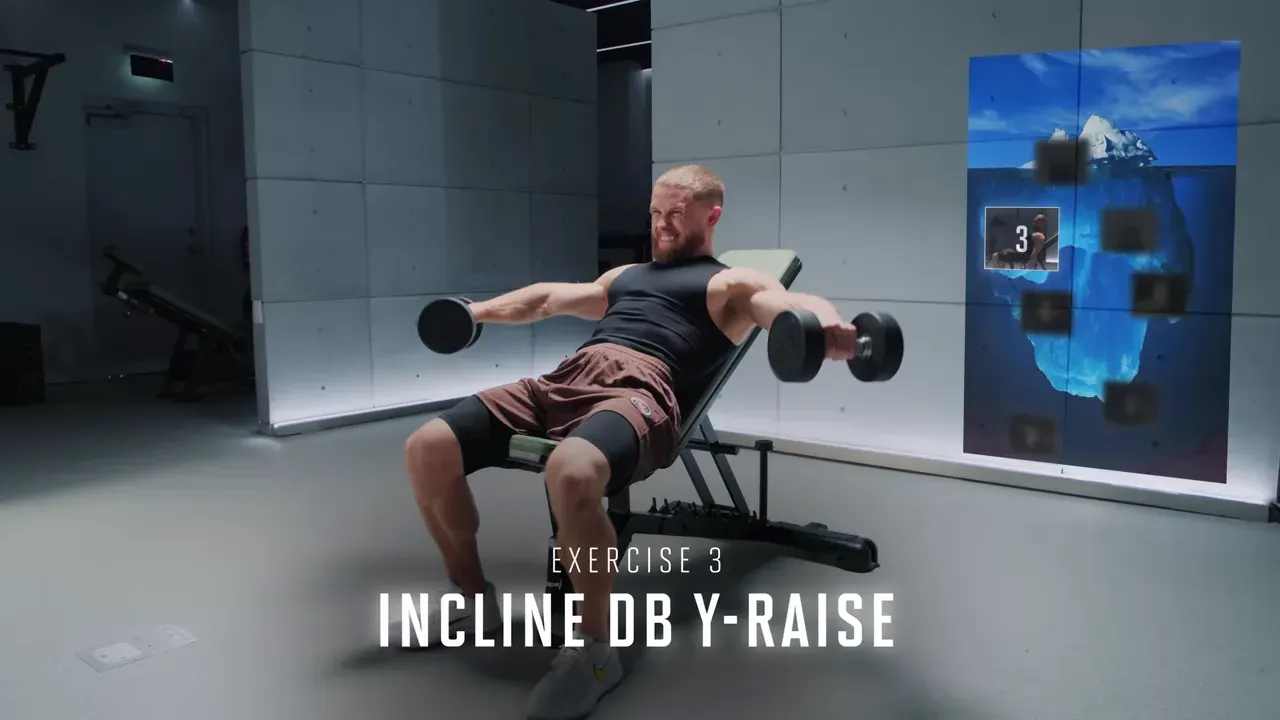
Why This Variant Matters
- More mid-range tension: You feel the delt from start to finish, not just at the top.
- Better front-to-side integration: The Y path hits fibers that add shape when viewed from the front.
- Less impingement risk for those who prefer a slightly forward plane (scapular plane).
How To Perform
- Set bench at 20–30° incline. Lie chest against the pad. Lift your chest slightly and brace upper back.
- With dumbbells at your sides, lift up-and-out into a Y shape. Squeeze the side delt on the way up and feel a gentle stretch on the way down.
- Stop the eccentric once the dumbbells reach your sides — do not let them hang vertically to avoid losing tension.
- Use light to moderate weight. The movement is about quality and connection.
Programming Tip
Include these in direct shoulder work days: 3–4 sets of 8–15 reps. Use lighter loads and perfect tempo to emphasize shape, not brute load.
Core And Posterior Chain Specials
Sideways One-Arm Rear Delt Fly On Pec Deck — Stretch The Rear Delt
Most people perform the reverse pec deck facing forward and miss the stretched range. Turning sideways lets you sweep the arm across the body. That stretch at the start of the eccentric provides a fuller range and better hypertrophy stimulus for the posterior deltoid.
Why This Fix Is Useful
- The traditional pec deck often keeps rear delts in a shortened range.
- Sideways execution lets you reach across the body and truly lengthen the rear delt before the concentric.
- Better stretch can mean fuller development and improved shape from the rear and back of the shoulder.
How To Do It
- Turn sideways on the pec deck. Grip with one hand and sweep the arm across your body in a controlled arc.
- Think about a big pile of money on the floor — how much area you cover is how much you keep. Sweep with the rear delt, not the back.
- Don’t over-rotate the torso. Keep the movement isolated and controlled.
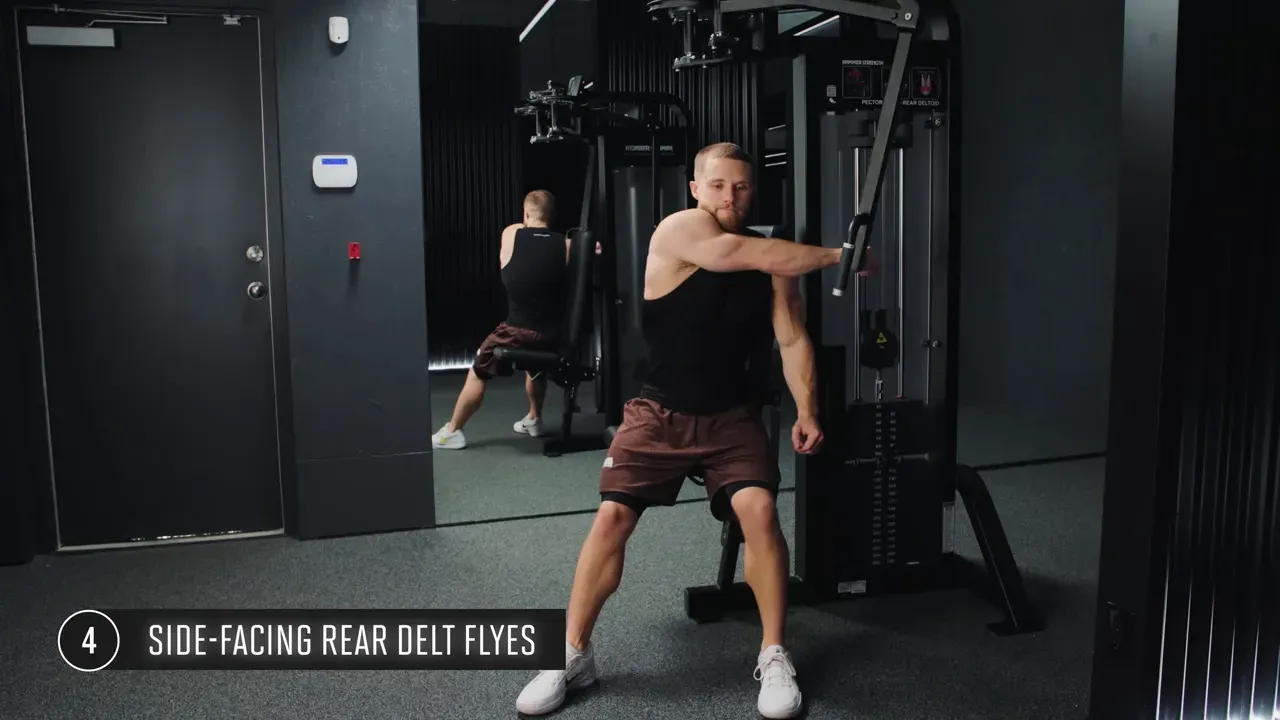
Alternatives
- Cables: Stand and reach across the body for the same stretched start.
- Dumbbells: Lie on a bench and stretch the dumbbell across your torso before lifting back up.
Dragon Flags — High-Intensity Core Strength
Dragon flags are a classic core move. They demand high anterior chain stiffness and control. Done correctly, they train the lower abs intensely while your entire midsection works isometrically to keep the spine extended.
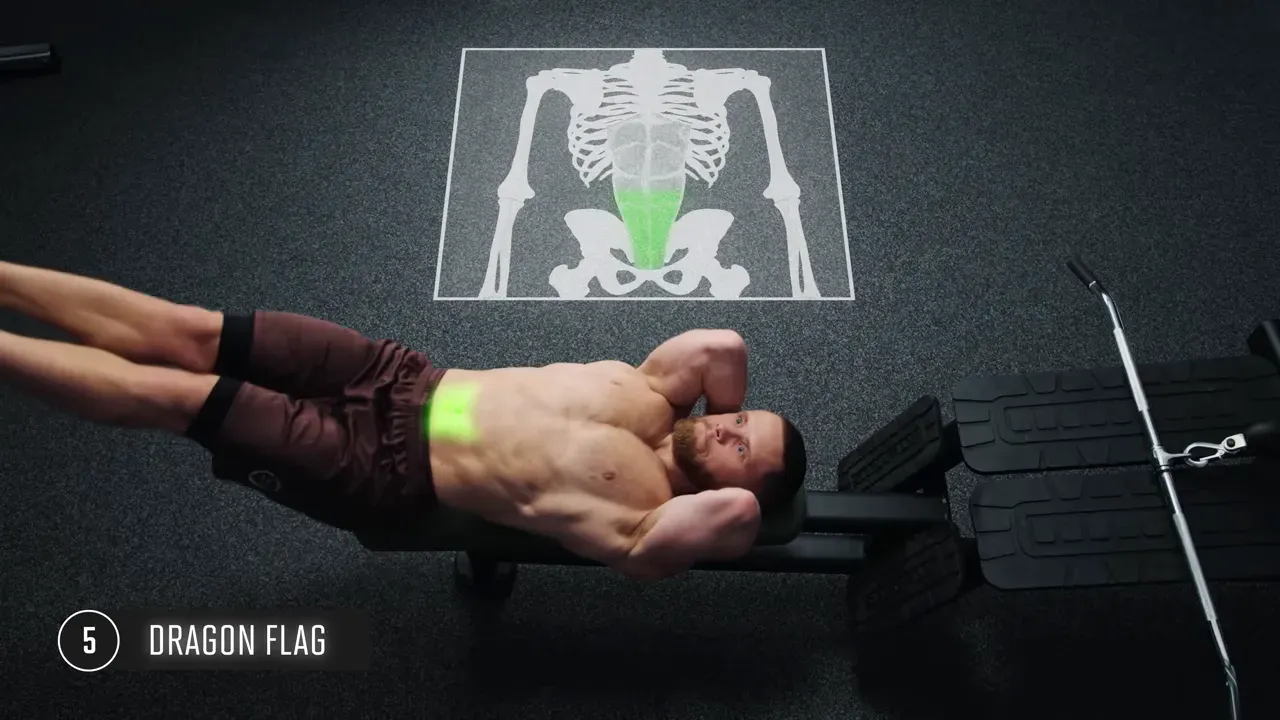
Why They Work
- Builds raw core strength and anti-flexion capacity.
- Engages serratus, lats, and obliques for torso stability.
- Great transfer to improved bracing for heavy compound lifts.
How To Progress
- Start with lying leg raises. Hit 8–10 reps with tension.
- Progress to bent-knee dragon flags. Train 8–10 reps clean before full extension.
- Then attempt full dragon flags for 4–8 reps per set.
Programming Note
Dragon flags are demanding. Do them 1–2 times per week, 3–4 sets of 4–8 reps. Prioritize control over reps. Remember, visible abs require diet — aim for ~10–12% body fat for men and ~20% for women to see a six-pack.
Keelso Shrug — Isolate Mid Traps Without Biceps Fatigue
The Keelso shrug is a locked-arm chest-supported row that isolates the mid traps and rhomboids. It moves a small vertical distance and emphasizes scapular squeeze rather than elbow flexion. That small range is often neglected but is where the mid-back builds thickness.
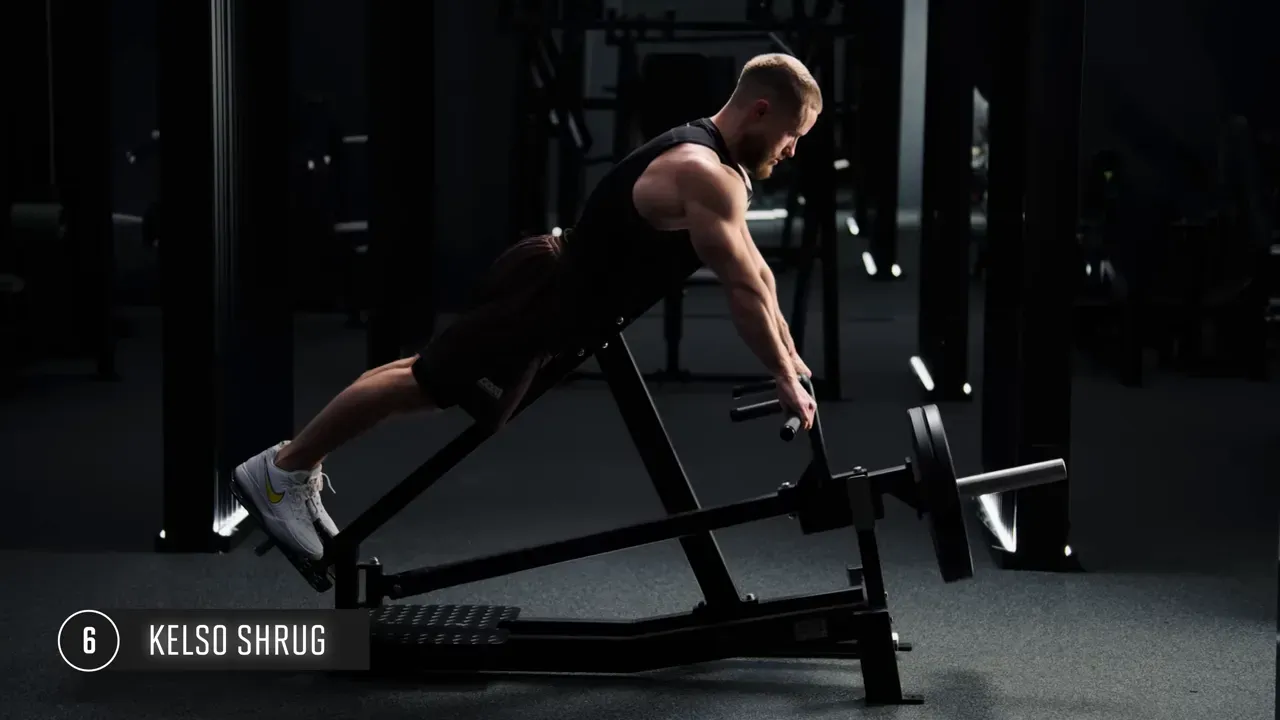
Why It’s Special
- Removes biceps from the movement by locking elbows.
- Isolates mid-back without taxing lower back or hamstrings.
- Builds thickness where most rows fatigue earlier due to smaller muscles.
How To Perform
- Use a chest-supported T-bar or brace on an incline bench with dumbbells.
- Grip about 1.5× shoulder width. Unrack. Keep arms locked.
- Squeeze shoulder blades together forcefully for ~1 second. Allow shoulder blades to peel apart slowly.
- Expect ~4–5 inches of movement. That’s normal for pure scapular retraction.
Programming Tip
Use Keelso shrugs after heavy rows: 3–5 sets of 6–12 slow reps to build mid-back density. If your rows fail due to biceps fatigue, Keelso shrugs let your mid-back still get high-quality volume.
Seated Cable Deadlift — Posterior Chain Focus Without Central Fatigue
This looks odd at first. You sit with glutes on a bench and perform a deadlift pattern from a seated start using a low cable. Why bother? Because it fixes the hips and removes lower-back and balance demands while biasing the glutes and hamstrings. The result is an intense glute pump and safer posterior overload.
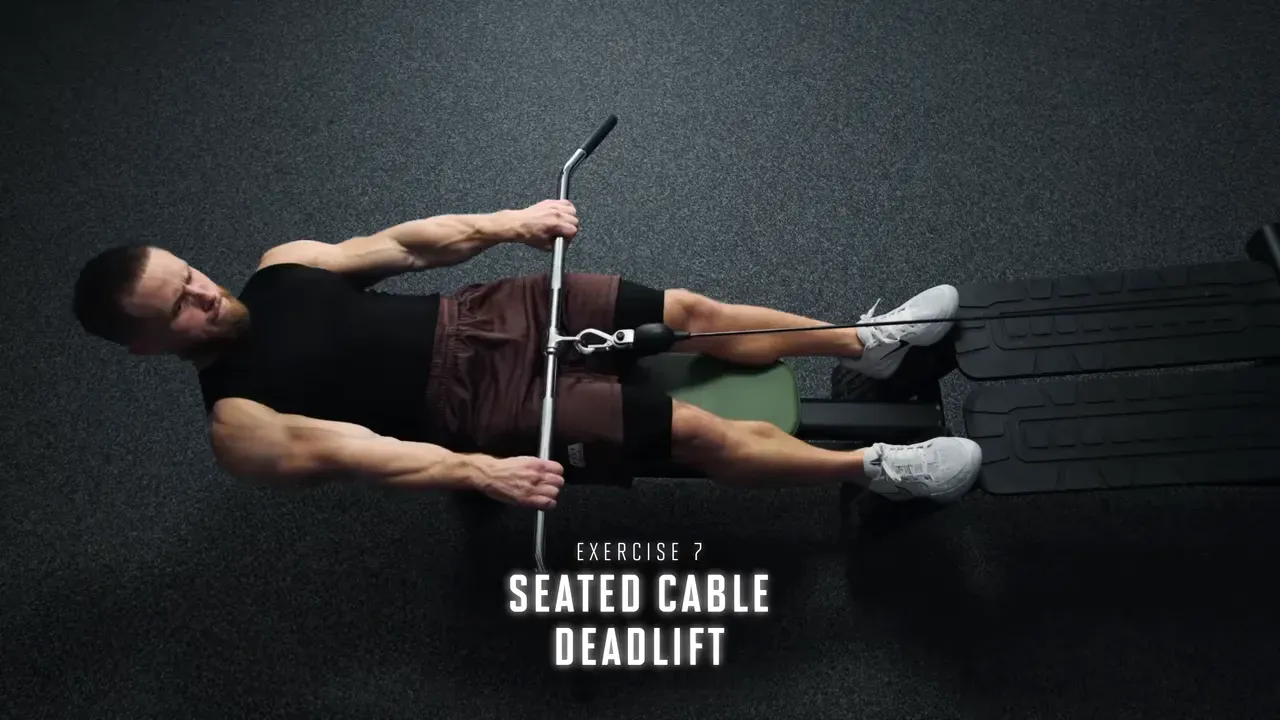
Why This Helps
- Lower systemic fatigue than heavy barbell deadlifts.
- Greater hip isolation — glutes work more due to anchored hips.
- Excellent single-leg or R/L balance work without balance worries.
How To Execute
- Grip about shoulder-width on the handle. Feet on platform, toes slightly turned out.
- Squat the weight up and set into full lockout with glutes planted on the bench.
- Start reps by unlocking hips and knees. Lower with the bar close to the body, go as low as safe (often to ankles).
- Squeeze glutes hard to extend hips to lockout. Do not yank with arms — it’s a hip-driven movement.
Variations
- Romanian style: keep a straighter knee to bias hamstrings.
- Single-leg: perform unilateral seated cable deadlifts to address imbalances.
Programming Note
Include 3–5 sets of 6–12 reps depending on whether you want more glute pump (moderate reps) or hamstring emphasis (higher reps with straighter knee).
Hidden-Gems Hypertrophy Plan
This mini-program is built around the main insight: add targeted, high-quality isolation and tension-profile exercises that your main compounds miss. Use this to add shape, fix weak links, and boost week-to-week progress.
Program Overview
- Ideal for: lifters seeking shape, thickness, and problem-area growth.
- Equipment needed: pull-up bar, dumbbells, incline bench, pec deck or cable, chest-supported row or T-bar, low cable machine, bench.
- Schedule: 4 days/week (Upper A, Lower A, Upper B, Lower B) for 6 weeks as a block.
Workout
Each session pairs a compound with 1–2 hidden gems. Use a mix of rep ranges: strength (4–6), hypertrophy (8–15), endurance (20–60s hangs).
Upper A
- Pull-up or lat pulldown — 3 sets × 6–10 reps, rest 2–3 min
- Bench press or DB press — 3 sets × 6–10 reps, rest 2–3 min
- Keelso shrugs — 4 sets × 8–12 reps, rest 90–120s
- Incline dumbbell Y raise — 3 sets × 10–15 reps, rest 60–90s
- Dead hang (grip/shoulder) — 3 sets × timed holds (20–60s), rest 60s
Pro tips:
- Do Keelso shrugs after rows to fully engage mid traps without biceps limit.
- Use light weight and high focus on the Y raise — the movement is shape work.
Lower A
- Back squat or front squat — 3–5 sets × 5–8 reps
- Seated cable deadlift — 4 sets × 8–12 reps, rest 90–120s
- Leg curls — 3 sets × 10–15 reps
- Calf work — 3 sets × 12–20 reps
Pro tips:
- Finish with glute-focused tempo on seated cable deadlifts for pump.
- Keep chest tall and bar path tight for best glute engagement.
Upper B
- Incline bench — 3 sets × 6–10 reps
- One-arm pec-deck rear delt fly (sideways) — 4 sets × 10–15 reps
- Zapman hammer curls — 3 sets × 8–10 reps
- Accessory triceps work — 3 sets × 8–12 reps
- Dead hang — 2 sets × 30–90s
Pro tips:
- Use the pec deck sideways to get a full stretch at the start of each rep.
- Match tempo and control on Zapman negatives for best hypertrophic effect.
Lower B
- Romanian deadlifts — 3–4 sets × 6–10 reps
- Seated cable deadlift single-leg — 3 sets × 8–12 reps each leg
- Goblet or Bulgarian split squats — 3 sets × 8–12 reps
- Core: dragon flag progressions — 3 sets (progress)
Pro tips:
- Start single-leg seated cable deadlifts with weaker side first. Match reps with stronger side.
- Use bent-knee dragon flags early in the cycle if full dragon flags are not yet feasible.
Notes On Program Execution
- Progress by 1–2 reps per set per week or increase load by 2.5–5% every 2 weeks.
- Prioritize sleep and protein intake (~1.6–2.2 g/kg) for hypertrophy and recovery.
- Replace a hidden gem with a similar movement if equipment is unavailable.
Want to automate workouts like that and more? Put your progress on autopilot with Dr. Muscle AI. Try Dr. Muscle AI—it's free.
Expert Corner: Proven Strategies & Hidden Gems
Practical Applications
- Use dead hangs to measure progress: test once every 1–2 weeks and log increases of 5–10 seconds.
- Swap standard curls for Zapman sets for two weeks to overload eccentrics and monitor biceps soreness and size changes.
- Replace one set of standing laterals with incline Y raises each shoulder session to improve front-to-side shoulder shape.
- Add Keelso shrugs at the end of back days for 3–5 sets to bring up mid-back thickness if you stall on rows.
- Use seated cable deadlifts on lower days when you need posterior chain stimulus without CNS-taxing bar deadlifts.
Examples:
- Example 1: If rows fail at 8 reps due to biceps, add 3 Keelso sets of 8–10 at end of session to keep mid-back volume high.
- Example 2: On a deload week, replace heavy deadlifts with seated cable deadlifts (3 sets × 12 reps) to keep stimulus but reduce soreness.
Fact-Check Of Key Points
- "Dead hangs can open up the shoulder joint" — Accurate as a functional statement: hanging increases joint distraction and promotes range if done pain-free.
- "You're about 40 or 50% stronger on the negative than you are on the positive" — This is a general observation; eccentric strength commonly exceeds concentric strength substantially in untrained and trained lifters.
- "The rear delts don't get anywhere close to a stretch position until you reach across your body" — Correct for many pec-deck setups; sideways execution increases initial stretch.
- "Dragon flags hit your lower abs the hardest" — True: raising legs against gravity biases the lower rectus and the anti-flexion demand is high.
- "Keelso shrug isolates mid traps and rhomboids without fatiguing lower back or biceps" — Accurate when performed correctly with locked arms and chest support.
More Little-Known Tips For Getting The Most
- On dead hangs, rotate shoulders slightly to find a range that feels best for your scapular mobility. Small tweaks matter.
- On Zapman curls, a 3–4s eccentric gives the most bang-for-buck hypertrophy stimulus without needing heavier concentric overloads.
- For pec-deck rear delts, slow eccentric and a 1–2s pause in the fully stretched position improves stretch-mediated hypertrophy signaling.
Common Mistakes With These Moves & How To Fix Them
- Dead hang mistake: gripping too tight from the start and fatiguing forearms. Fix: start with a loose grip and increase tension as needed.
- Zapman curl mistake: letting arm swing and using shoulder to compensate. Fix: keep elbows near torso and use a controlled arc.
- Incline Y mistake: letting dumbbells drop behind sides and losing tension. Fix: stop at sides and maintain continuous tension.
- Pec-deck rear delt mistake: using torso rotation to yank weight. Fix: keep torso stable and use rear delt to sweep the arm.
- Dragon flag mistake: dropping hips or allowing lumbar rounding. Fix: keep hips and knees straight; regress to bent-knee variation.
- Keelso shrug mistake: trying to create large ROM. Fix: accept the small scapular-only ROM and squeeze hard.
- Seated cable deadlift mistake: yanking with arms. Fix: cue hip hinge and glute drive; use a full glute squeeze at top.
Science of the Best Resistance Training Exercises
Resistance training is universally recognized for improving muscular strength, body composition, metabolic health, and even cognitive function. But when it comes to selecting the "best" exercises or approaches, systematic reviews and meta-analyses emphasize that effectiveness depends more on how training is structured—volume, intensity, and consistency—than on specific exercises alone.
Key Findings from Meta-Analyses and Systematic Reviews
- Whole-body training consistently improves strength and health outcomes. Meta-analyses suggest that resistance programs including 8–10 exercises targeting all major muscle groups, performed 2–3 times weekly, are optimal for health and longevity benefits (Porter, 2000), (Pollock & Evans, 1999).
- Compound, machine-based, or multi-joint exercises are highly effective. For older adults, machine-based resistance training was found to significantly improve both functional and strength outcomes (Kirk et al., 2024).
- Training intensity, not volume, may matter more. Some analyses show that low-volume, high-intensity training (even a single set) can be as effective as multiple-set protocols for strength gains (Winett, 2004).
- Resistance training improves more than strength. It significantly reduces body fat, visceral fat, and improves bone mineral density and joint flexibility (Wewege et al., 2021), (Massini et al., 2022), (Favro et al., 2024).
- Health benefits go beyond fitness. Resistance training reduces the risk of all-cause mortality by up to 27%, particularly with about 60 minutes per week of training (Shailendra et al., 2022).
Practical Applications of Science
- Include compound exercises (e.g., squats, presses, rows) or machine-based multi-joint movements for safety and effectiveness.
- Train each major muscle group at least 2–3 times per week with moderate to high effort.
- Higher intensity may deliver similar results to high-volume programs, saving time.
Scientific Conclusion
There is no single "best" exercise, but resistance training that targets all major muscle groups, emphasizes intensity over volume, and is performed consistently offers the broadest health and strength benefits across populations.
My Opinion On Little-known Exercises
In my view, the classic compound movements—like squats, deadlifts, bench presses, and rows—remain the foundation of any well-designed strength or hypertrophy program. These tried-and-true lifts offer the broadest muscle recruitment and have the strongest backing in both science and real-world results.
That said, it’s absolutely fine to experiment with more targeted or unconventional moves, like those highlighted here. Exercises such as the Y raise, Zapman curl, Keelso shrug, and the seated cable deadlift can be useful as accessory work to address stubborn weak points, add variety, or reduce overuse injuries from repetitive patterns. If you enjoy them and they fit your goals, feel free to include one or two as a supplement to your main lifts.
Ultimately, consistency and progression with the basic lifts will deliver most of your results. Use exercises like these as optional tools in your toolbox—not as a replacement for the proven classics, but as a way to keep your training fresh, shore up weaknesses, and add new challenge whenever needed.
Concluding On These Seven Moves
These seven exercises are not magic. They are small, targeted interventions that fix weak links. They add time under tension, improve shape, and reduce compensatory limits from smaller muscles. If you want more muscle and less fat, use them smartly within a solid program and a proven nutrition plan.
Consistency beats novelty. But adding a few new, well-chosen movements can keep your training fresh and unlock stubborn gains.
Try one new exercise from this list every 1–2 weeks and track changes in strength, size, and shoulder comfort. That slow, methodical approach wins more often than chasing the next trendy movement.
Want to automate this kind of progression and get personalized workouts that evolve automatically? Try Dr. Muscle AI—it's free. It will help you schedule these moves, adjust volume, and keep progress steady without guesswork.
FAQ
How Long Should You Dead Hang?
A dead hang is a timed grip-hold from a bar. Beginners should aim for 10–30 seconds per set. Progress gradually; many trained lifters can reach 60–120 seconds per hang with practice. Use bands or assistance if you cannot sustain bodyweight initially.
What Is A Zapman Curl?
A Zapman curl is a dumbbell curl where you curl with a hammer grip and rotate to supination on the eccentric. This places more eccentric load on the biceps by recruiting brachialis and brachioradialis concentrically and forcing the biceps to control the negative.
Why Do Incline Y Raises Better Than Lateral Raises?
Incline Y raises change the tension profile so delts feel load across a larger portion of the range of motion. They target fibers between the front and side heads for improved shape and can feel easier on people with shoulder discomfort.
Are Dragon Flags Safe?
Dragon flags are safe when progressed properly. Start with lying leg raises and bent-knee progressions before attempting full dragon flags. Keep strict control and avoid lumbar rounding to protect your lower back.
What Muscles Do Keelso Shrugs Target?
Keelso shrugs primarily target mid traps and rhomboids by isolating scapular retraction with locked arms. They build back thickness without fatiguing biceps or lower back when done on a chest-supported setup.
Do Seated Cable Deadlifts Replace Barbell Deadlifts?
Seated cable deadlifts don’t replace barbell deadlifts for maximal strength. They are a complementary option that lets you overload glutes and hams with less CNS and spinal stress, making them ideal for recovery-focused training blocks.
How Often Should I Drink MacroFactor Or Use Nutrition Apps?
MacroFactor is a nutrition app that many lifters use for tracking calories and macros. Use it daily to log food and weekly to check progress. Adjust calories every 1–2 weeks based on weight trends and fat-loss progress for reliable changes.
What Rep Ranges Work Best For These Exercises?
Use a mix: 6–8 reps for heavier Keelso shrugs or seated cable deadlifts, 8–15 for Y raises and Zapman curls, and 3–8 for dragon flags depending on progression. Deadhangs are timed holds (20–120s) rather than reps.
How Do I Fix Shoulder Pain With These Moves?
Start with low-intensity dead hangs and incline Y raises. Build shoulder tolerance slowly; avoid pain and sharp twinges. Seek professional evaluation if pain persists or is severe.
How Do I Balance This With My Existing Program?
Pick 1–2 of these exercises per week and add them to your accessory slot. Keep main lifts as priority and use these moves to add volume for specific weaknesses or shape. Monitor recovery and adjust volume if soreness accumulates.
Final note
These seven exercises are practical tools you can add today. They help you build more muscle, reduce fat, and shape a better physique when combined with consistent training and solid nutrition. For automated program progression and personalized adjustments using these movements and more, Try Dr. Muscle AI—it's free.
We used AI to summarize the video 7 Amazing Exercises No One Does (ALL S TIER) while drafting this expert review.

